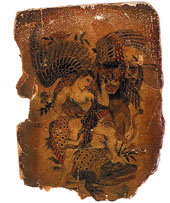
old fashioned tattoo
"Body marking and above all tattooing and
ritual branding and scarring represent
a form of social practice reaching beyond
the bounds of the individual whilst
simultaneously being determined by,
and inseparable from, the individual."
(Stephan Oettermann
"The History of the Tattoo in Europe")

modern tattoo
"You shall not make any cuttings in your flesh on account of the dead or tattoo any marks upon you: I am the Lord."
(Book of Moses, 3:19;28)
As far as we know, this quote from the Bible is the earliest written account of tattoos. For thousands of years human beings of different cultures have been applying this technique to communicate and to store information permanently, or rather for as long as it is in use, i.e. the duration of a person's life.
Whether tattoos fulfill a purely cosmetic or more explicitly political function, they are always inextricably linked with processes of communication in terms of their expressing (or concealing) personal identity.
Moreover, taking into account the medium's long tradition, the human body, i.e. its skin may conceivably also be used in the digital age as a data bank and to transmit information. This would involve using skin to store digitalized information and to decode it as required. An example of such coding and decoding is offered by the barcode (EAN) which is to be found on consumer goods. This is of particular interest with regard to mobile communication processes. Wherever one happens to be, one's body would contain retrievable information at all times. And more importantly, once the information has been translated or decoded it can be transmitted everywhere.